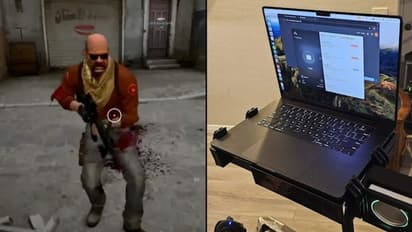Neuralink's 2nd patient masters 'Counter-Strike 2', Elon Musk envisions millions Neuralinked by 2034 (WATCH)

Synopsis
Neuralink, the brain-computer interface company led by Elon Musk, has announced that its second human participant, Alex, is now able to play video games and use CAD software entirely through brain signals.
In a groundbreaking update, Neuralink, the brain-computer interface company led by Elon Musk, has announced that its second human participant, Alex, is now able to play video games and use CAD software entirely through brain signals. This achievement marks a significant milestone for Neuralink, which aims to revolutionize interaction between the human brain and technology.
Alex, who had previously lost control of his limbs due to a spinal cord injury, underwent the Neuralink implant surgery at the Barrow Neurological Institute in Phoenix, Arizona. Remarkably, he was discharged the day after the procedure.
According to Neuralink's latest blog update, Alex was able to control a computer cursor with his mind within five minutes of the surgery. His capabilities extended beyond mere cursor control to engaging in complex tasks, such as playing the popular first-person shooter game Counter-Strike 2 and using CAD software Fusion 360.
Prior to the implant, Alex had relied on a mouth-operated controller known as the QuadStick, which allowed him to control game movements or aiming, but not both simultaneously. With the Neuralink chip, Alex can now manage both actions effortlessly, enhancing his gaming experience significantly.
The blog featured a video of Alex playing Counter-Strike 2, demonstrating his newfound ability to aim and move simultaneously, something he found previously impossible with his old setup.
"Just running around is so enjoyable because I can look side to side, and not need to move Quadstick left and right," Alex commented. "I can [think about where to] look and it goes where I want it to. It's insane."
Elon Musk has expressed high hopes for the future of Neuralink, predicting that within the next decade, millions of people could be Neuralinked. In a recent post, Musk suggested that streets might soon be filled with individuals equipped with Neuralinks, if the technology continues to progress successfully.
"Update about the second Neuralink device in a human. If all goes well, there will be hundreds of people with Neuralinks within a few years, maybe tens of thousands within 5 years, millions within 10 years," wrote Musk in a post on X.
Neuralink’s blog update on Alex's progress aligns with Musk’s ambitious vision, showcasing the potential of brain-computer interfaces to enhance everyday activities and communication.
Neuralink's first patient, Noland Arbaugh, had faced complications with electrode threads retracting from his brain, which impacted the device’s functionality. However, the company reported that Alex’s implant did not experience this issue. Advances in surgical techniques and device design have contributed to this improvement, including reducing the likelihood of air pockets forming during surgery and positioning the implant deeper into brain tissue.
The announcement has elicited a range of reactions online. While some have expressed excitement over the technological advancements, others have voiced skepticism and concern. Meta’s chief AI scientist, Yann LeCun, humorously questioned whether there would be more Neuralink users or Tesla robotaxis within the next five years. Critics have raised concerns about the potential dystopian implications of Neuralink’s technology, with some users referring to it as part of a "transhumanist agenda" or even likening it to a "Terminator" scenario.
Looking ahead, Neuralink is focusing on enhancing the functionality of its brain chips. The company plans to enable the technology to interact with the physical world, potentially allowing users to control robotic arms or wheelchairs, and to perform tasks like feeding themselves more independently. These advancements aim to extend the capabilities of Neuralink devices beyond digital interfaces, providing broader applications for individuals with disabilities.
Find the latest Technology News covering Smartphone Updates, AI (Artificial Intelligence) breakthroughs, and innovations in space exploration. Stay updated on gadgets, apps, and digital trends with expert reviews, product comparisons, and tech insights. Download the Asianet News Official App from the Android Play Store and iPhone App Store for everything shaping the future of technology.